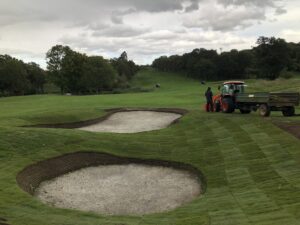Meet the course manager: James Bonfield
Related Articles
From The Hertfordshire, James talks about the course improvements that have stemmed from a new owner investing in the facility and upgrading – particularly the bunkers – while keeping the course open.
A chance suggestion by a teacher set James Bonfield on a path he has followed professionally for 22 years. As course manager of The Hertfordshire Golf and Country Club, a 6,276 yard 18-hole parkland course in Broxbourne, he is currently overseeing an ambitious project to upgrade the infrastructure of the course, which was originally designed by Jack Nicklaus II and opened in 1995. We spoke to him about positive changes made by the new owners of the club, the benefits of working with apprentices, and using YouTube as a tool to communicate with members.
Could you tell us about your background and how you became course manager at The Hertfordshire Golf and Country Club?
I was all set to go to university to study business, but I found it quite dull. The teacher asked what I wanted to do so I told her I grew up on a farm, liked working outdoors and was also keen on golf, and she asked me if I’d be interested in becoming a greenkeeper. She got me into Oaklands College and the rest is history. I’ve gone back and seen her since to say thank you. So I studied for a national certificate in greenkeeping and sports turf management without actually working on a golf course at the time. After I passed that I got a job at Welwyn Garden City Golf Club as an assistant greenkeeper and became a deputy at Trent Park, eventually taking over as course manager. When there was an opening at The Hertfordshire, which was part of the same group as Trent Park at the time, I applied for that and started as course manager there in April 2010. I took over as a regional manager for a time and looked after five courses and was course manager of two courses, The Hertfordshire and Mill Green, for a while too. In 2019 The Hertfordshire got taken over by our current owners, Elysium Golf, and I decided to stay with them.
What size is your team and how do you share the workload between you?
Currently we’ve got ten staff, which includes me, a mechanic and a gardener, and the rest are greenkeepers. I’ve got a deputy course manager, John Hart, and a first assistant, and various qualified and apprentice greenkeepers on the team. We’re recruiting for one more greenkeeper at the moment [late April 2022] to complete the team so everyone can do one in three weekends. Our new owners are very supportive of us expanding the team. If we highlight a problem or something we feel we need they ask us what we think the solution is and listen to our suggestions. Thankfully the owner of Elysium Golf really enjoys and understands golf and loves the course here.
What makes the course stand out and what are the trickiest aspects for your team to maintain?
When the course was first built in 1995 it was done on quite a small budget, which meant some aspects of the infrastructure were not built and had to be done further down the line. The course is really well laid out, the undulations and the features are fantastic, but we’ve had to keep adding to the infrastructure over the years. Drainage, general soil profiles and things like that have had to be improved as we move forward. We’ve also added runoffs around the greens. A lot of courses are flat around the greens, but I really like the fact that this course has got a lot of undulations around the greens and the fairways and we can really have some fun with it and make it interesting as you go around. We never forget that the course is the focal point.
The tees are round and not really big enough for the number of members we have playing now, so over the last few years we’ve spent a lot of time upgrading them and making them bigger. They’re still round because of the way they’re designed and built onto mounds, but we can drop the mounds and make them wider and we’ve spent a lot of time trying to get more teeing area. We’re not overly long. It’s a very challenging course but it does mean the longer hitters are taking more irons than drivers off the tees, so we get quite a bit of wear on that side of things. This time of year the main challenge is maintaining the tees and in winter it’s the drainage. Since Elysium took over we’ve invested very heavily in drainage and bought our own excavator and trencher, so we can do everything in-house.
We’ve spent a lot of money on drainage material to try to get the course as playable as possible all year round because a membership is 365 days a year and members want to be able to make the most of it. In the south east of England on London clay the surface is never going to be like a links course, but we can get it playing very well. Rain-wise this winter has been a little better for us than the last two winters. The challenge this winter has been having the members around all year, as opposed to the last two seasons where we were closed a lot [due to the pandemic] and we were able to push forward and get a lot done. It’s great to see the members back but it is an added pressure. We did have to close when Storm Eunice arrived in February. It was the first time we’ve had to close due to wind but it needed doing. It was crazy, but only one big tree went over so we got off very lightly. Sadly the wall that surrounds what used to be the rose garden of the Grade II listed mansion overlooking the golf course did blow over that day and we were lucky that was the worst of it.
What do you enjoy most about your job and what has been your biggest challenge to date?
All of it, to be quite honest. I can’t imagine doing anything else. When I first went into greenkeeping everything clicked. Things I learned about at school, like photosynthesis, suddenly made sense as soon as I applied it to golf courses and greenkeeping. Every day is different and I get to be outdoors, so as far as I’m concerned it’s the best job in the world. You get to play golf at the end of the day if you want to and you’re constantly seeing the course evolving. I could never imagine doing anything else after this. I’ve also travelled and been to America twice as a result of greenkeeping.
My biggest challenge to date is probably what we’re working on at the moment. We’re essentially upgrading the whole golf course around the golfers. Trying to keep things playable while moving forward with work like building bunkers, rebuilding tees, doing drainage, while keeping everything as open as possible is challenging. The project keeps evolving because as we do one thing it becomes obvious we need to do something else, and we’ve been allowed to do that, which has made the job very enjoyable and exciting. We‘re very much commanding our own destiny at the moment and, on the whole, the members are very supportive of what we’re doing. Communication with the members is key. I do a vlog [on Youtube] where I record myself walking round around the course and update them on what’s going on. One member said recently that one of the reasons he joined the club was because of that type of communication.
What has been your proudest achievement in the job so far?
Seeing a team go from inexperienced to experienced and qualified is very fulfilling. A couple of years ago we had four or five apprentices and they’re mostly qualified now. Seeing the team evolve together, and what we can achieve as a result, is incredible. We can manage so much of what we need to do with taking the course forward in-house now, because of the level of expertise. Seeing the team become that kind of team is something we’re all very proud of. Currently we’ve got two guys who’ve just finished their level two qualification and we’ll hopefully be starting another two on the same path this year. We haven’t brought anyone in who’s been qualified for a good few years now; we’ve brought in apprentices and trained them up. That way we can mould them into what we need and all move forward together. I’ve got 22 years of experience, my deputy’s got 17 or 18, so between us that’s nearly 40 years and we know what we want and what kind of people will fit in with the team. We can keep the team moving forward like that and it works for us.
A personal achievement for me was being part of the BIGGA and Bernhard delegation to America in 2018. You apply for it, they whittle it down to 20 and they take ten. I still speak to the other nine guys I went with every day on a WhatsApp group, even though our jobs and roles have changed since then. It was a great experience. We went to the golf industry show in San Antonio, hosted the BIGGA booth and networked in the evening. I’d definitely recommend doing that to anyone who can.
You’ve installed Capillary Bunkers via Border Sports on the course. What problems were you facing beforehand and how have Capillary Bunkers made a difference?
The drainage was poor before, they were full of stones and the sand was always getting contaminated because, although the original bunkers were built well and shaped very nicely, they were massive and you could never keep enough sand in them due to wind and rain.
One of the first things the new owners talked about was getting them sorted out, so we looked at various options and went with Capillary Bunkers. It’s been great so far and the new bunkers and the old bunkers are like chalk and cheese.
We can’t wait to get the rest of the course done. The new bunkers are so much easier to look after, so much easier to maintain. Every aspect of it is a plus, as far as I’m concerned. When we have heavy rain we can walk outside straight afterwards and rake the bunkers because they aren’t full of water, so that side of things is brilliant.
Because we’re installing Capillary Bunkers ourselves we’re redesigning the bunkers as we go, using some lovely shapes that are already there in the undulations of the course. We’re also saving money because we don’t have to top up the sand all the time. One of the Capillary Bunkers has been in for three seasons and I’m yet to have to top it up. By the time we’ve converted all our bunkers we shouldn’t need to spend much on bunker sand every year.
How many bunkers have you installed Capillary Bunkers on? Was the installation process straightforward?
We’ve done seven and we’re just about to do another six. The actual installation of a Capillary Bunker is probably the easiest part. Depending on how many we’re doing it takes about a day to install them. It arrives on a concrete lorry and gets tipped into the bunker, we smooth it out, put the liner over the top of it for the night, so that it can dry without getting rained on, then within 24 hours we can take off the covers and within 48 hours we can they’ve got sand in them. Designing the shapes and building the revetting faces of the bunkers takes a bit more time.
Have you had any feedback about Capillary Bunkers from the members?
Feedback has been extremely positive. The golfers love them because they’re very playable bunkers and they look good too.
What are you working on at the moment and what other projects have you got planned for this year?
Today we’ve been designing two of the bunkers we’re going to do with Capillary, so we’ve been in there shaping them with the JCB before the revetting turf turns up.
As well as the huge project we’re constantly working on we’re also working on a hedgerow restoration project. Holes two to eight are owned by separate landowners and used to be farmland a long time ago and the hedge around it used to be good enough to hold cattle in, but since it became a golf course it has taken time to understand what was needed to maintain the hedgerow and it got too tall and wispy, and parts of it started to die. Since the new owners have come in we’ve spoken to the landowner, who’s very knowledgeable, about what we can do to improve it. This year we’re starting to cut the hedge right down and we will replant it and get it back to its former glory. It helps offset the course when it’s neat and tidy, and it benefits everyone.
We’ll also be working on paths and path edges during this season, and next winter we’ll be doing more work on bunkers, tees and drainage. The big plan for next winter is to upgrade our first tee.
What advice would you give to anyone hoping to follow the same career path as you?
Go for it. To start off with the money isn’t great, but if money is your motivation it probably isn’t for you. If you want to work outdoors and get fulfillment from what you do then it’s a very rewarding career. It’s taken me around the world and anyone getting into it could end up working on golf courses all over the world. To anyone who’s just started greenkeeping I would say decide what you want to get out of the job and then just go for it. There are lots of colleges offering the courses and lots of companies willing to offer you advice. Every greenkeeper I know is very happy to talk about the job and how you could progress. I think it’s a very friendly industry and you don’t realise how big it is until you go somewhere like the BTME show in Harrogate or the GIS show in America. Even if you get into greenkeeping and decide it isn’t quite for you there are so many options in other parts of the industry like machinery sales, the fertiliser and chemical side of things. It’s an industry with a lot of opportunities.

































